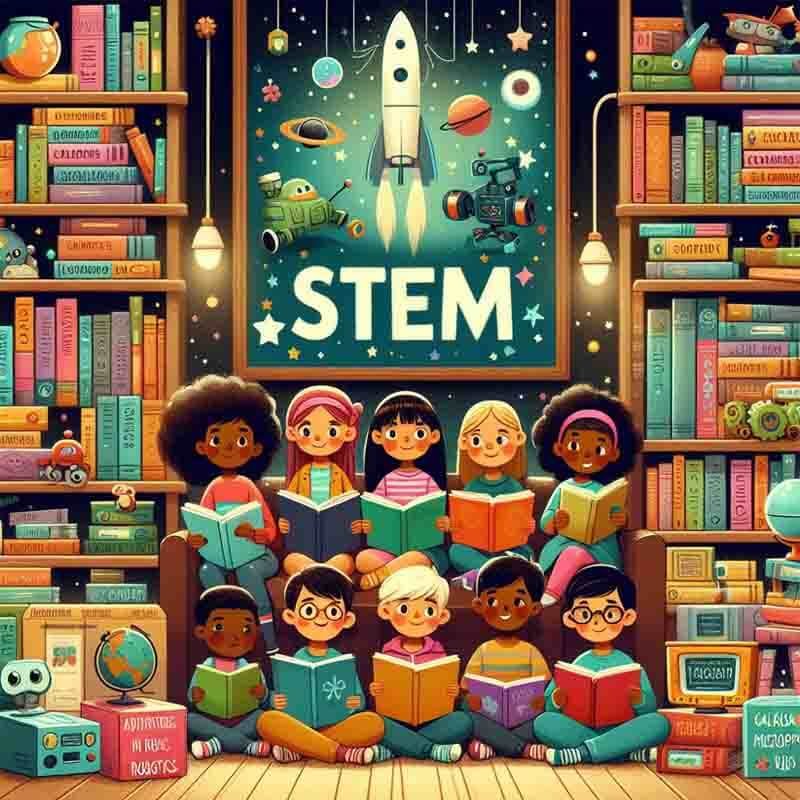Exploring the World of STEM Through Children's Books
Exploring the World of STEM Through Children's Books
STEM books for kids offer a world of exploration through picture books that teach STEM concepts to young readers. To foster understanding of science and technology, these bestselling titles from the U.S National Inventors Hall of Fame® showcase the diversity in STEM and empower children to explore the STEM disciplines.
From the true stories of historical inventors to the mathematical adventures of fictional characters, books for kids provide fun and informative learning environments. During the COVID-19 pandemic, this charming book series has become a staple in science teachers and book clubs as they curate a new generation of readers eager to discover the natural world.
One new book in this series tells the true story of Rosa and her twin brother Johnson's journey into the world of invention. Through their inventive minds, they explore the math concepts that embark them on a journey of discovery in the STEM field. As STEM books for kids continue to empower and educate young minds, these nonfiction picture books are essential in promoting literacy and understanding of the world.
The importance of STEM education for children.
STEM (Science, Technology, Engineering, and Mathematics) education is becoming increasingly important for children as we live in a constantly evolving world that relies on these fields. Children need a strong foundation in STEM subjects as they grow and enter the workforce.
STEM education teaches children about these specific fields and helps develop critical thinking, problem-solving, and analytical skills necessary for success in any career. It also encourages creativity and innovation, which are essential for progress and advancement.
Additionally, STEM education can help bridge the gender gap in these industries by encouraging girls to pursue careers in these traditionally male-dominated fields. Introducing children to STEM at an early age prepares them for a future increasingly reliant on technology and innovation.
Benefits of using children's books to explore STEM concepts.
Introducing children to STEM concepts early can have numerous benefits. One way to do this is through the use of children's books. Not only are books a fun and interactive way to introduce these concepts to children, but they also have numerous other benefits. First and foremost, books are a great way to spark a child's curiosity and imagination. Children's books can use engaging and colorful illustrations to make STEM concepts more relatable and exciting for young minds.
Additionally, books can help develop a child's language and vocabulary skills as they learn new terms and concepts. Children's books can also promote critical thinking and problem-solving skills as they follow along with characters and their various STEM adventures. Furthermore, using books to explore STEM concepts can help break down gender stereotypes and encourage girls to pursue interests in these fields.
Overall, using children's books to explore STEM concepts is a fun and effective way to introduce children to these critical subjects and help them develop crucial skills for the future.
STEM-themed children's books to engage young minds.
STEM-themed children's books provide a powerful tool to kindle the imaginative minds of young readers. With topics ranging from simple machines to extreme weather, these kid-friendly books invite young ones to understand the world through a scientific method.
The New York Times bestselling Girls Who Code series celebrates the achievements of young innovators and national science heroes like the first black woman astronaut. Every child can aspire to invent and bud into a world-famous problem-solver through beautifully illustrated pages and a handy glossary.
These STEM-themed children's books take readers on a thrilling journey, from exploring the four seasons to learning how plants and animals overcome challenges like a blizzard. The stories in these books educate and inspire young readers to embrace their curiosity and love for science. Each beautifully illustrated page endlessly sparks the imagination of kids ages 6-12, making them see the world's wonders in a new light.
Here are some of the top STEM-themed children's books that will engage and inspire young minds.
"Rosie Revere, Engineer" by Andrea Beaty is a story about a young girl who dreams of becoming an engineer and learns to never give up on her dreams.
"Ada Twist, Scientist" by Andrea Beaty follows a young girl who always asks questions and seeks answers, inspiring a love for science.
"Iggy Peck, Architect" by Andrea Beaty tells the story of a young boy who loves to build and create, showing the importance of creativity and STEM skills.
"The Most Magnificent Thing" by Ashley Spires teaches children the value of perseverance and problem-solving as a young girl tries to create the perfect invention.
These books promote STEM education and teach essential life lessons that inspire young minds to pursue their passions.
How to incorporate STEM books into daily reading routines.
STEM books are a great way to introduce children to these subjects while promoting a love for reading. However, it can be challenging to incorporate these books into daily reading routines. One way to do this is by setting aside a specific day to read STEM books. This could be during bedtime or after school. You can also make it a fun activity by creating a designated reading corner with books and activities related to STEM.
Another way to incorporate STEM books is by choosing books that align with your child's interests and hobbies. For example, if your child loves animals, you can select a STEM book about animal habitats or behavior.
Interactive STEM activities to complement reading sessions.
Incorporating interactive STEM activities into reading sessions is a great way to engage children and make learning more fun and hands-on. These activities can help children develop critical thinking, problem-solving, and collaboration skills while reinforcing the concepts they learn through reading.
One idea is to have children build models or structures related to the book they are reading. For example, if the book is about animals, children can use building blocks to create habitats for the animals in the story.
Encouraging curiosity and critical thinking through STEM literature.
STEM is a great way to encourage curiosity and critical thinking in children. By incorporating STEM concepts into children's books, we can introduce them to these subjects fun and engagingly. These books can spark children's interest in STEM and encourage them to ask questions, explore, and think critically. They can also help children see the real-world applications of STEM and how these subjects are relevant to their daily lives.
When choosing STEM literature for children, it is essential to look for books that teach the basic concepts and encourage children to think beyond what is presented. Look for books with open-ended questions, experiments, or activities children can do independently. This will allow children to explore and discover independently, fostering their curiosity and critical thinking skills.
Furthermore, it is essential to choose diverse and inclusive STEM literature. Representation matters, and children should be able to see themselves in the stories and characters they read about.
Tips for parents and educators on how to engage children with STEM books.
Tips for parents and educators:
When engaging children with STEM books, make it a fun and interactive experience for them.
Ask questions about the book's content and encourage them to share their thoughts.
Make connections to real-life experiences and let them explore the concepts endlessly.
#Book celebrates: Choose books that celebrate diversity in STEM fields to show children that anyone can excel in these areas regardless of background. This will inspire them to pursue their interests and passions in STEM subjects.
#Puppy: Use props like toy animals or a puppy to make the readings more engaging and memorable. Create hands-on activities related to the book's themes to deepen their understanding and make learning enjoyable.
#Caregiver: Encourage children to ask questions and be curious about the world around them. As caregivers or educators, they should foster their love for STEM by providing hands-on experiments and exploration opportunities that align with the book's content.
Additional suggestions to assist children in connecting with STEM literature:
Choose books with colorful illustrations and interactive elements: Children are drawn to books with vibrant colors and features like pop-ups, flaps, and puzzles. These elements make the learning experience more fun and hands-on.
Use real-life examples and relatable stories: Children are more likely to engage with a subject if they can relate it to their lives. Look for books that use real-life examples or tell stories children can connect with.
Encourage hands-on learning: STEM books can be a great starting point, but hands-on activities are essential for children to truly understand the concepts. Look for books that include experiments, projects, or activities children can do at home or in the classroom.
Ask open-ended questions: Instead of just reading the book, encourage children to think independently.
Conclusion: Nurturing a love for STEM through the power of storytelling.
In conclusion, incorporating storytelling into STEM(Science, Technology, Engineering, and Mathematics) education can tremendously impact nurturing a love for STEM in children. By using creative and engaging stories, students can see the real-world applications of STEM subjects and develop a deeper understanding and appreciation for them. These stories also help to break down barriers and stereotypes surrounding STEM fields, making them more accessible and inclusive for all students.
FAQ:
Q. What age is appropriate for introducing STEM concepts to children?
A: There's no one-size-fits-all answer, but STEM concepts can be introduced early through play and simple activities. Children's books specifically designed for STEM learning can be a great introduction from toddlerhood onwards.
Q. Are STEM books just for boys?
A: Not! Choosing diverse and inclusive STEM literature that features girls and characters of all backgrounds is essential. This can help make STEM more relatable and inspiring for all children.
Q. How much time should I dedicate to reading STEM books with my child?
A: Even short bursts of reading can be beneficial. Consistency is key, so aim for a brief daily or regular read-aloud session focused on STEM topics.
Q. My child isn't interested in reading. Can I still use STEM books?
A: Yes! Look for books with interactive features, pop-ups, or flaps. You can also use STEM books as a springboard for discussions and hands-on activities related to the topic.
Q. What if I need to improve in science or math? Can I still help my child with STEM books?
A: Definitely! Your enthusiasm and encouragement are more important than having all the answers. Explore the books together, ask questions, and find answers online or at the library.
Q. Are there any benefits to using audiobooks instead of physical books?
A: Audiobooks can be a great option, especially for longer books or during car rides. However, physical books offer the advantage of interacting with illustrations and following along with the text. You can use both interchangeably, depending on the situation.

